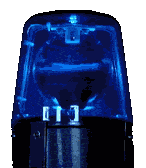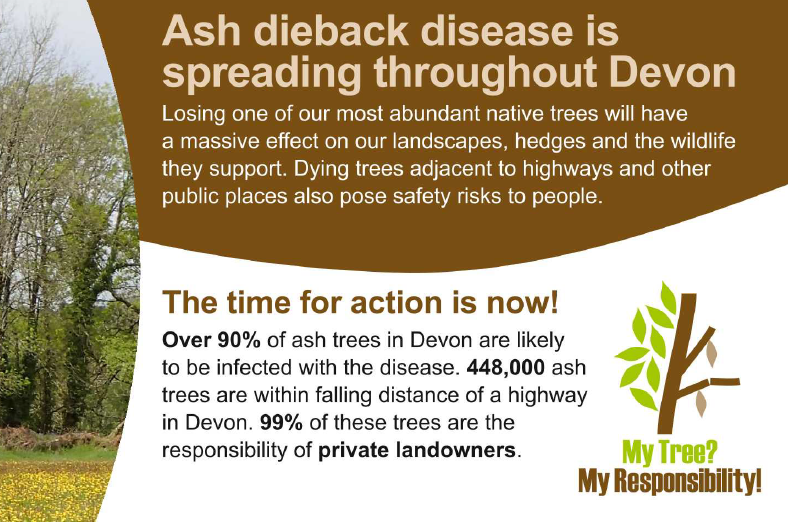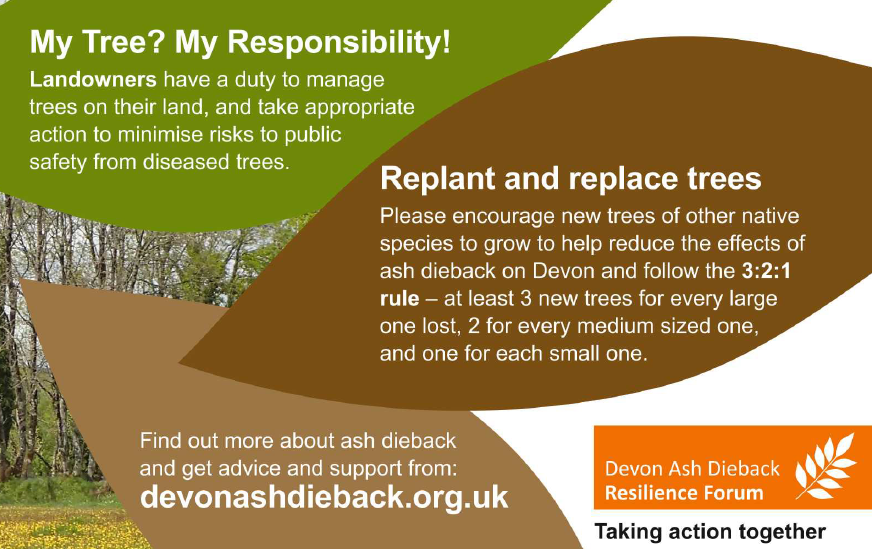From time to time the Brentor Village website posts useful articles about aspects of living in Brentor. These are gathered together on this page for future reference.
Click on the links below to jump to the information article of your choice
Brentor Emergency Plan
Protecting Dartmoor sheep – valuable assets
Keeping our roads clear of water
Ditch and hedge maintenance responsibilites
Reporting potholes
Cattle can be dangerous
Ash dieback disease
Brentor Parish Council has written an emergency plan for our parish, along with a home emergency booklet which will soon be printed and delivered to every home.
Emergencies can affect our parish with little or no notice. Being
prepared can help reduce the effects on our lives, reduce the need for help from others and enable us to support the vulnerable in our community.
There are many ways an emergency can affect our busy everyday lives, from disruption to essential services such as water, electricity and telecoms to regional and national travel. Covid19 has shown us that we need to plan for the unexpected.
Click here to see the Brentor Community Emergency Plan
Click here to see the Brentor Home Emergency booklet
Protecting Dartmoor sheep – valuable assets
The Mary Tavy Commoners’ Association has provided the following information:
Sheep are valuable assets and any harm to them harms a farmer’s livelihood. It is every dog’s instinct to chase, even if they are usually obedient and good with other animals.
Chasing by dogs can do serious damage to sheep, even if the dog doesn’t catch them. The stress of worrying by dogs can cause sheep to die and pregnant ewes to miscarry their lambs.
Sheep fleeing from dogs are often killed or seriously injured by their panicked attempts to escape, causing untold damage to fences and field boundaries in the process. Dogs chasing ewes and lambs can cause mis-mothering issues, with lambs dying from starvation or hypothermia when they become separated from their mother and fail to find her again.
Dog bites can cause death in sheep or necessitate them being put down at a later date, or in less severe cases considerable veterinary bills and additional welfare issues as a result of flies being attracted to the blood and leading to a nasty health problem in sheep called ‘fly strike’. Injuries to sheep can also delay the normal farming routine, be it the mating season or administration of vital medicines and vaccines.
It is an offence to allow a dog to worry sheep. Worrying includes attacking or chasing sheep and, in some circumstances, farmers are legally entitled to shoot dogs if they are endangering their sheep
It is vital that you keep your dog on the lead around livestock, even if you can usually trust it to come to call. If you live in or near a farming area, you must make sure that your dog cannot escape from your property, as it may find its way onto land containing sheep.
 The Countryside and Right of Way Act (CROW Act) sets out public rights of access to open land and the restrictions to these rights. Although CROW allows anyone on to open access land (land you can access without having to use paths, including mountains, moorland, heaths, downs and registered common land) for recreation, the Act states that the public can only go on this land if they keep dogs on a fixed lead of 2 metres or less near livestock. The owner of open access land can close areas containing sheep to dogs for up to six weeks once a year, as a safeguard during lambing. Trained guide and hearing dogs are still allowed in these areas during this closure.
The Countryside and Right of Way Act (CROW Act) sets out public rights of access to open land and the restrictions to these rights. Although CROW allows anyone on to open access land (land you can access without having to use paths, including mountains, moorland, heaths, downs and registered common land) for recreation, the Act states that the public can only go on this land if they keep dogs on a fixed lead of 2 metres or less near livestock. The owner of open access land can close areas containing sheep to dogs for up to six weeks once a year, as a safeguard during lambing. Trained guide and hearing dogs are still allowed in these areas during this closure.
Dartmoor national Park Bylaw 9
9 Dogs
(1) Every person in charge of a dog on the access land shall as far as is reasonably practicable keep the dog under close control and restrain the dog from behaviour giving reasonable grounds for annoyance
(2) Every person in charge of a dog on the access land shall, as far as is reasonably practicable, comply with a direction given by a Ranger or other officer of the Authority to keep the dog on a lead.
(3) A direction under paragraph 2 above may only be given if such restraint is reasonably necessary to prevent a nuisance or behaviour by the dog likely to cause annoyance or disturbance to any person on the access land or the worrying or disturbance of any animal or bird.
Keeping our roads clear of water
First published in February 2017

Walking around Brentor you may have noticed that many of our roadside ditches and watercourses have been cleared of debris that has been building up for some time.
Water can now drain off the roads more easily, avoiding the formation of puddles that can be a danger to traffic and pedestrians. This is thanks to the work of the local Parish lengthsman, whose recent work has been funded by a grant obtained by the Parish Council.

The County Council also employs their own lengthsmen who are scheduled to work for four days a year in Brentor. In addition if there is flooding or large puddles on a road the County Council will, 24 hours after the rain has stopped, take action if:
-
- the road is impassable
- the water is forcing vehicles, cyclists or pedestrians away from the nearside of the road by more than one metre
- vehicles have to cross the centre line marking
They undertake to attempt to clear the standing water if appropriate. If unable to clear the water, they will set up a flood sign, guard the area or close the road to make the location safe and then investigate a permanent solution.
To find out more click here to visit the County Council’s highways website.
 Thanks should also go to the Parish Council which recently obtained a grant to rebuild the culvert in the centre of the village – the resulting work has made a huge improvement to the water flow and will help to reduce the amount of water that spills onto the road in very wet weather.
Thanks should also go to the Parish Council which recently obtained a grant to rebuild the culvert in the centre of the village – the resulting work has made a huge improvement to the water flow and will help to reduce the amount of water that spills onto the road in very wet weather.
The parish lengthsman can only do a limited amount in the time he has, so it’s worth watching out for blocked gullies and drains and helping by keeping them clear of debris!
Ditch and hedge maintenance responsibilities
First published on 15th February 2020
The February storms have brou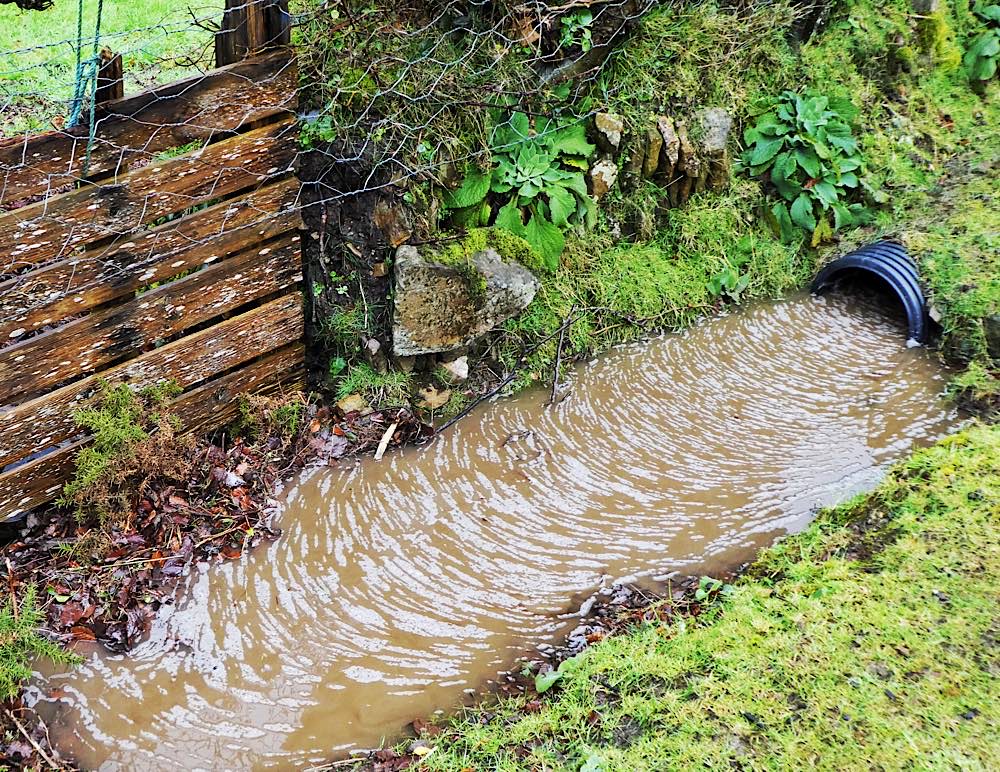 ght the issue of drainage into sharp focus. Drain and ditch clearance has always been important in Brentor, but the effect of climate change, bringing heavier and more frequent rain and storms, is now making this even more vital.
ght the issue of drainage into sharp focus. Drain and ditch clearance has always been important in Brentor, but the effect of climate change, bringing heavier and more frequent rain and storms, is now making this even more vital.
At a recent Town and Parish Conference a great deal of interest was shown in who is responsible for maintaining and clearing drainage systems on and around Devon’s highways. Significant public funds have been invested by Devon County Council in a programme of ditch clearance to drain the water from the highway. However, in the majority of cases, the responsibility for ditch maintenance rests with the adjacent landowner, even if the ditches take water from the highway. Therefore local authority funding is being used to undertake works which are, in part, the responsibility of the landowners! This is reducing the funds available to undertake works which really are the authority’s responsibility.
Also landowners and occupiers are required by law to trim any hedge next to the public highway where the growth is preventing the passage, or affecting the safety, of the highway user.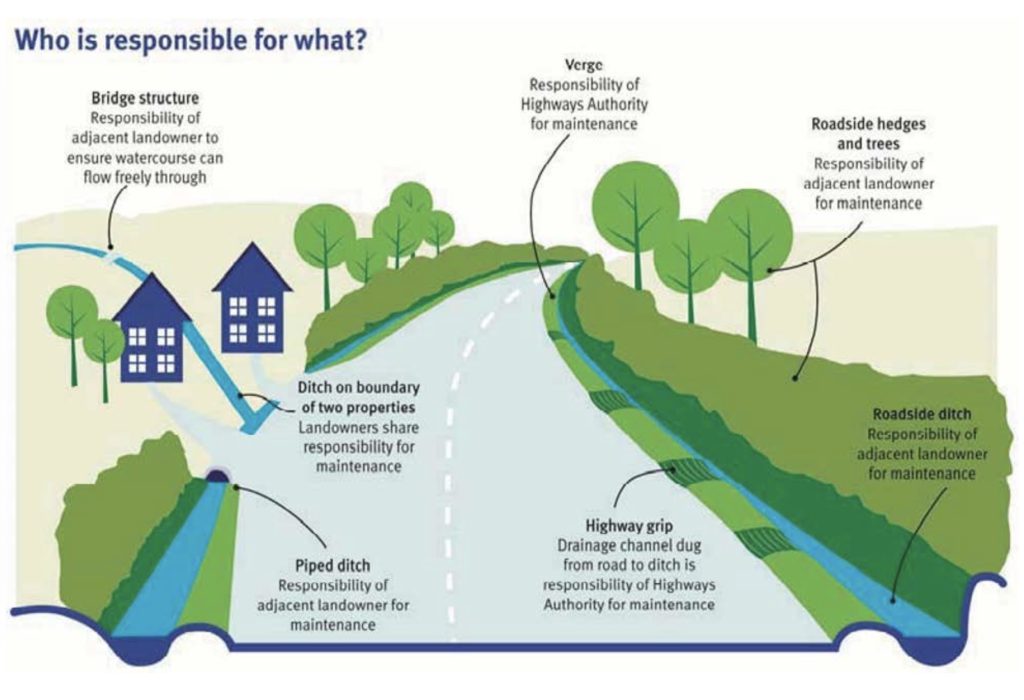 It’s worth taking a look at the following documents if you own property by a road:
It’s worth taking a look at the following documents if you own property by a road:
• A factsheet titled Roads and farmers produced by Devon County Council.
• Information regarding overgrown vegetation is available on the Devon County Council website here by clicking here.
After the wet and freezing weather potholes seem to appear overnight in our local roads. It is easy to report them for repair – click here to go to the Devon County Council roads and transport website page to report them.
You’ll need to take a photograph and note where the pothole is, so that you can mark its position on the County Council’s website, but it’s easy and worthwhile to do and it could prevent an accident.
If you are reporting an emergency that requires immediate attention, please call the County Council on 0345 155 1004. An emergency on the highway is defined as something that is very likely to present an imminent threat to life or serious injury or serious damage to property.
Cattle can be dangerous
 During the summer of 2018 a Brentor resident was injured by one of the highland cattle that graze the moor on Gibbet Hill. She needed medical treatment. Another dog walker has also reported his dog being chased by a cow, and then being approached himself by the animal.
During the summer of 2018 a Brentor resident was injured by one of the highland cattle that graze the moor on Gibbet Hill. She needed medical treatment. Another dog walker has also reported his dog being chased by a cow, and then being approached himself by the animal.Kevin Hilborn, who owns the cattle, has made the following comments in an email to the Editor of this website, in response to an article about the injury incident in the September 2018 edition of Brentor News:
‘I own the highland cattle and would like to point out that you have missed the crucial part of why the cow reacted how she did. The lady had three dogs running and they went between the cow and its young calf. All cattle with calves are very protective and will react to dogs going too close. There was a reason behind it, not just a random occurrence. We have seen people walk straight through the middle of them instead of going round, and trying to get photos.
Please ask people to give them space and not to take dogs near them. Please respect the animals on the moor, plenty of room for everyone and everything.’
If you walk through a field of cows with calves, think twice – if you can, go another way and avoid crossing the field.

